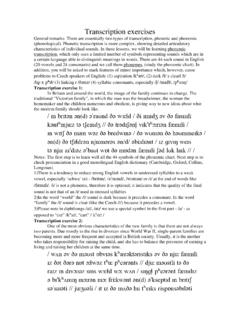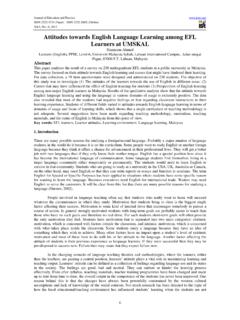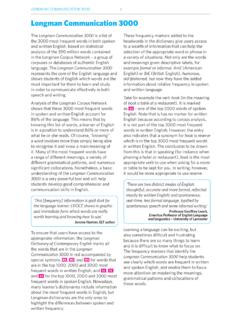Transcription of The role of teachers’ classroom discipline in their ... - ed
1 Iranian Journal of Language Teaching Research 3(1), (Jan., 2015) 57-82 57 * Corresponding author: English Department, Faculty of Humanities, Shahid Rajaee Teacher Training University, Lavizan, Tehran, Iran Email address: Urmia University Press Urmia University This study investigated the role of EFL teachers classroom discipline strategies in their teaching effectiveness and their students motivation and achievement in learning English as a foreign language. 1408 junior high-school students expressed their perceptions of the strategies their English teachers used (punishment, recognition/reward, discussion, involvement, and aggression) to discipline the classroom . The students evaluated their teachers teaching effectiveness by completing effective Iranian EFL teacher questionnaire (Moafian, & Pishghadam, 2009). They also filled in Attitude/Motivation Test Battery (GhorbanDordinejad & ImamJomeh, 2011) that assessed their motivation towards learning English as a foreign language.
2 Achievement in English was established based on formal grades students received at the end of the academic year. The results showed that EFL teachers reward and praise students for good behavior and they are not very authoritarian. Further, teaching effectiveness, motivation and achievement in learning English were all found to be related to discipline strategies. The results of path analysis showed that those teachers who used involvement and recognition strategies more frequently were perceived to be more effective teachers; however, students perceived teachers who used punitive strategies as being less effective in their teaching. It was also revealed that in classes where teachers managed disruptive behaviors by using punitive strategies, students had problems in learning as punitive strategies lowered students motivation. Teaching effectiveness was found to mediate the effect of punishment on motivation while motivation mediated the effect of punitive strategies on achievement.
3 Motivation was found to have the strongest effect on achievement. Keywords: achievement; classroom discipline ; motivation; teaching effectiveness; teachers Urmia University Press Received: 30 June 2013 Revised version received: 5 Dec. 2014 Accepted: 9 Dec. 2014 Available online: 1 Jan. 2015 The role of teachers classroom discipline in their teaching effectiveness and students language learning motivation and achievement: A path method Mehrak Rahimi a, *, Fatemeh Hosseini Karkami a a Shahid Rajaee Teacher Training University, Iran A B S T R A C T A R T I C L E S U M M A R Y Content list available at Iranian Journal of Language Teaching Research 58 Rahimi & Hosseini/The role of teachers classroom .
4 Introduction The prevalence of problematic and disruptive student behavior in schools of almost all parts of the world has called attention to extensive research on finding the sources of such behavior and developing foundations to educate teachers who can effectively manage their classes through adopting appropriate discipline strategies. The significance of classroom discipline and management has been appreciated both from a social practice perspective and an effective teaching stand. Socially, teachers discipline strategies have been suggested to be a potent force to promote students sense of responsibility in the classroom (Lewis, Romi, Qui, & Katz, 2005) and to produce more responsible citizens at a grand vision (Lewis, 2001). Effective teaching research also shows that a sufficient degree of classroom discipline is needed to create an atmosphere conducive to student learning as students misbehavior distracts the process of learning and teaching and ruins the effectiveness of even the most carefully planned lessons (Barton, Coley & Wenglinsky, 1998).
5 Teachers behavior and management styles attach a special significance to this issue as the intervention techniques teachers choose to manage their classes are perceived to be the sign of their professional adequacy by students (McCormick & Shi, 1999) and an important motivator of learning (Muller, Katz, & Dance, 1999). A non-threatening learning environment develops a sense of belonging among students (Freeman, Anderman, & Jensen, 2007), makes them self-initiated and self-confident (Rogers, 1983), and thus increases their desire for learning. Conversely, if teachers act coercively by adopting punitive discipline strategies, learning is negatively affected (Banfield, Richmond, & McCroskey, 2006) and more psychological and somatic complaints are heard in the classroom (Sava, 2002). This issue complicates teacher role in the classroom and makes dealing with persistent behavior problems a formidable challenge that is one source of teacher job stress and burnout (Lewis, 1999).
6 classroom management particularly raises key issues in EFL classes and is one of the biggest challenges language teachers face while they teach (Linse & Nunan, 2005). On the one hand, a language teacher tries to be a kind and loving caregiver to let the genuine communication happen in the classroom (Williams & Burden, 1997). On the other hand, in order for the instruction to take place, the teacher should maintain order to manage language activities most effectively. It is not, therefore, easy for a language teacher to create the balance between these two, that is, a caring environment and a controlled one. Further, teachers and their caring behavior are considered to be among the most important environmental factors that can help learners to develop positive attitudes towards language learning and promote students effort or engagement in doing language learning tasks (Williams & Burden, 1997).
7 As a result, second language motivation research places a heavy emphasis on teachers role in motivating language learners (D rnyei, 1994) and minimizing the level of their demotivation (Gorham & Christophel, 1992). However, it is still unknown if language teachers discipline strategies have any effect on their teaching effectiveness (as perceived by students) and their students motivation and achievement in learning a foreign language. The aim of the present study is thus threefold. First, the strategies teachers use to discipline students misbehavior in English as a foreign language classes are investigated. Second, the relationship between these strategies and teachers teaching effectiveness, and students learning motivation and achievement is sought. Finally, the inter-relationships would be modeled using a series of paths and statistically tested to find the predictors of motivation and achievement.
8 Iranian Journal of Language Teaching Research 3(1), (Jan., 2015) 57-82 59 Review of Related Literature classroom discipline The term discipline comes from the word discipulus in Latin which means teaching and learning. The term has the essence of control in it and means to teach someone to obey rules and control their behavior or to punish someone in order to keep order and control ( longman dictionary of Contemporary English, 2005, p. 443); and thus it is mostly connoted with punishment in case of disobedience. Punitive strategies such as detention are used in schools based on the premise that isolation gives the perpetrator time to reflect on what happened, realize the error of his or her ways, and return to the same situation but with a change of behavior and attitude (Pane, 2010, p. 88). Recent research on the issue of discipline strategies, however, has revealed that punitive strategies appear to be of limited usefulness in promoting responsible student behavior (Lewis, 2001) and should be replaced by proactive and interactive discipline practices (Pane, 2010).
9 In this framework, discipline is viewed to be associated with the act of teaching students self-control based on a contract that binds a teacher and a group of students together so that learning can be more effective (Harmer, 1983). Thus, emphasis is put on student self-regulation by negotiating, discussing, and contracting between teachers and students (Vitto, 2003) to let the group take responsibility for ensuring the appropriateness of the behavior of all its members (Johnson & Johnson, 2006). Effective classroom management is obviously linked to teachers ability to set an appropriate tone and gain learner respect and cooperation in class (Williams & Burden, 1997). As observable instructional behavior of teachers in the classroom is indicative of their teaching effectiveness (Kyriakides, Creemers, & Antoniou, 2009), the way teachers discipline their classes has a profound impact on the way they project themselves as effective teachers.
10 It is evident that more caring teachers choose relationship-based discipline strategies ( , discussing with students about their misbehavior) over coercive ones ( , aggression and punishment) in an attempt to prevent discipline problems (Noddings, 2007). A few studies support the fact that more caring teachers and those who use relationship-based discipline strategies are perceived to be more effective teachers by their students ( , Teven & McCroskey, 1997). When teachers involve students in decision makings or recognize their good behavior, they act more responsibly in class (Lewis, 2001), show more positive affect to their teachers, and express a greater belief that the intervention was necessary (Lewis, Romi, Katz, & Qui, 2008). Students prefer teachers who enact caring attitudes, establish community and family type environment, and make learning fun (Howard, 2001). This is rooted in the fact that caring teachers show more empathy towards their students and see a situation from their point of view and feel how they feel about it.
















